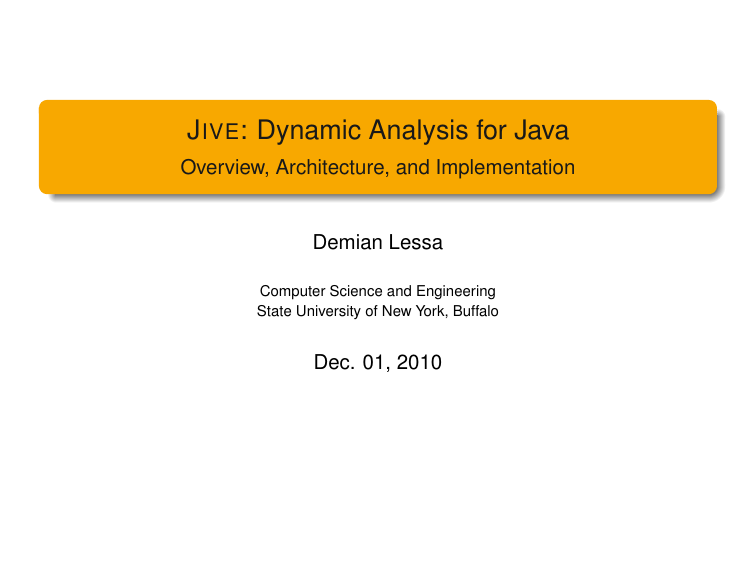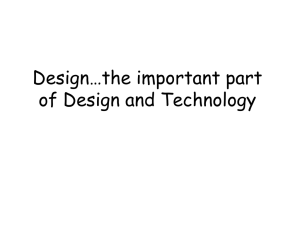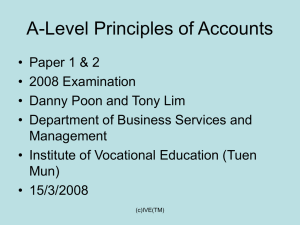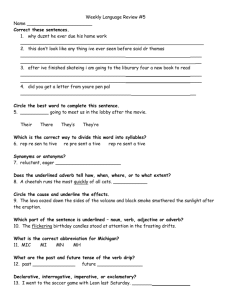J : Dynamic Analysis for Java IVE Overview, Architecture, and Implementation
advertisement

J IVE: Dynamic Analysis for Java Overview, Architecture, and Implementation Demian Lessa Computer Science and Engineering State University of New York, Buffalo Dec. 01, 2010 Outline Overview Architecture Implementation Conclusion Outline 1 Overview 2 Architecture 3 Implementation 4 Conclusion Demian Lessa J IVE: Dynamic Analysis for Java :: Overview, Architecture, and Implementation 2 / 23 Outline Overview Architecture Implementation Conclusion Next... 1 Overview 2 Architecture 3 Implementation 4 Conclusion Demian Lessa J IVE: Dynamic Analysis for Java :: Overview, Architecture, and Implementation 3 / 23 Outline Overview Architecture Implementation Conclusion What can you tell about a program? Questions we often need to answer about programs and their execution: How is the system designed? How do system components communicate? How does control flow during execution? How does the state of an object change during execution? Did an object ever have a particular state? At what times? What caused an object to have a particular state? How do threads and objects/methods interact? What caused a method to execute? Was a particular method ever called? At what times? What parameters were passed to a method call? What value was returned by a method call? Demian Lessa J IVE: Dynamic Analysis for Java :: Overview, Architecture, and Implementation 4 / 23 Outline Overview Architecture Implementation Conclusion How do you answer such questions? Pick the right technique(s) for the job. Static analysis looks at the code but does not execute it. all execution paths, undecidability issues, AST/DFG/CFG/..., etc; comprehension– architecture extraction, querying, etc; debugging– static checkers to match source code patterns. Demian Lessa J IVE: Dynamic Analysis for Java :: Overview, Architecture, and Implementation 5 / 23 Outline Overview Architecture Implementation Conclusion How do you answer such questions? Pick the right technique(s) for the job. Static analysis looks at the code but does not execute it. all execution paths, undecidability issues, AST/DFG/CFG/..., etc; comprehension– architecture extraction, querying, etc; debugging– static checkers to match source code patterns. Model checking verifies if a model of the program violates its specs. all execution paths, symbolic execution, state space explosion, etc; debugging– execution trace of a spec violation. Demian Lessa J IVE: Dynamic Analysis for Java :: Overview, Architecture, and Implementation 5 / 23 Outline Overview Architecture Implementation Conclusion How do you answer such questions? Pick the right technique(s) for the job. Static analysis looks at the code but does not execute it. all execution paths, undecidability issues, AST/DFG/CFG/..., etc; comprehension– architecture extraction, querying, etc; debugging– static checkers to match source code patterns. Model checking verifies if a model of the program violates its specs. all execution paths, symbolic execution, state space explosion, etc; debugging– execution trace of a spec violation. Dynamic analysis executes the code and looks at execution data. single execution path, probe effect, scalability, execution traces, etc; comprehension– interaction extraction, querying, etc; debugging– reverse execution, querying, etc. Demian Lessa J IVE: Dynamic Analysis for Java :: Overview, Architecture, and Implementation 5 / 23 Outline Overview Architecture Implementation Conclusion How do you answer such questions? Pick the right technique(s) for the job. Static analysis looks at the code but does not execute it. all execution paths, undecidability issues, AST/DFG/CFG/..., etc; comprehension– architecture extraction, querying, etc; debugging– static checkers to match source code patterns. Model checking verifies if a model of the program violates its specs. all execution paths, symbolic execution, state space explosion, etc; debugging– execution trace of a spec violation. Dynamic analysis executes the code and looks at execution data. single execution path, probe effect, scalability, execution traces, etc; comprehension– interaction extraction, querying, etc; debugging– reverse execution, querying, etc. Hybrid approaches combine aspects of the above techniques. symbolic execution for test generation; static analysis for selective tracing; ... Demian Lessa J IVE: Dynamic Analysis for Java :: Overview, Architecture, and Implementation 5 / 23 Outline Overview Architecture Implementation Conclusion Where does J IVE stand? J IVE is a dynamic analysis tool for Java programs featuring: Traditional, break-step-inspect interactive debugging. Demian Lessa J IVE: Dynamic Analysis for Java :: Overview, Architecture, and Implementation 6 / 23 Outline Overview Architecture Implementation Conclusion Where does J IVE stand? J IVE is a dynamic analysis tool for Java programs featuring: Traditional, break-step-inspect interactive debugging. Forward and reverse stepping/jumping. Revert to previous states in order to diagnose errors. Demian Lessa J IVE: Dynamic Analysis for Java :: Overview, Architecture, and Implementation 6 / 23 Outline Overview Architecture Implementation Conclusion Where does J IVE stand? J IVE is a dynamic analysis tool for Java programs featuring: Traditional, break-step-inspect interactive debugging. Forward and reverse stepping/jumping. Revert to previous states in order to diagnose errors. Dynamic visualizations of state and execution. UML-based object diagrams (ODs) for state snapshots. UML-based sequence diagrams (SDs) for execution. ODs clarify many aspects of OO semantics. SDs clarify concurrent program behavior and object interactions. Demian Lessa J IVE: Dynamic Analysis for Java :: Overview, Architecture, and Implementation 6 / 23 Outline Overview Architecture Implementation Conclusion Where does J IVE stand? J IVE is a dynamic analysis tool for Java programs featuring: Traditional, break-step-inspect interactive debugging. Forward and reverse stepping/jumping. Revert to previous states in order to diagnose errors. Dynamic visualizations of state and execution. UML-based object diagrams (ODs) for state snapshots. UML-based sequence diagrams (SDs) for execution. ODs clarify many aspects of OO semantics. SDs clarify concurrent program behavior and object interactions. Queries over execution traces. Investigate (temporal) program properties. Debug programs by identifying suspicious conditions. Integrate query answers with dynamic visualizations. Demian Lessa J IVE: Dynamic Analysis for Java :: Overview, Architecture, and Implementation 6 / 23 Outline Overview Architecture Implementation Conclusion Where does J IVE stand? J IVE is a dynamic analysis tool for Java programs featuring: Traditional, break-step-inspect interactive debugging. Forward and reverse stepping/jumping. Revert to previous states in order to diagnose errors. Dynamic visualizations of state and execution. UML-based object diagrams (ODs) for state snapshots. UML-based sequence diagrams (SDs) for execution. ODs clarify many aspects of OO semantics. SDs clarify concurrent program behavior and object interactions. Queries over execution traces. Investigate (temporal) program properties. Debug programs by identifying suspicious conditions. Integrate query answers with dynamic visualizations. Selective trace filtering. Focus on relevant parts of the source. Demian Lessa J IVE: Dynamic Analysis for Java :: Overview, Architecture, and Implementation 6 / 23 Outline Overview Architecture Implementation Conclusion J IVE in Practice Things you probably know... J IVE is integrated with Eclipse as a collection of plugins. Requires programs to execute in debug mode. To run J IVE, it must be enabled in your program’s debug profile. The J IVE perspective provides several views. Contour Model. Object Diagram. Sequence Model. Sequence Diagram. Event Log. Requires Java 1.6+ and Eclipse 3.5+; supports *ix, Mac, and Win. It has a home: http://www.cse.buffalo.edu/jive. It is open source: http://code.google.com/p/jive. Demian Lessa J IVE: Dynamic Analysis for Java :: Overview, Architecture, and Implementation 7 / 23 Outline Overview Architecture Implementation Conclusion J IVE’s User Interface Demian Lessa J IVE: Dynamic Analysis for Java :: Overview, Architecture, and Implementation 8 / 23 Outline Overview Architecture Implementation Conclusion Next... 1 Overview 2 Architecture 3 Implementation 4 Conclusion Demian Lessa J IVE: Dynamic Analysis for Java :: Overview, Architecture, and Implementation 9 / 23 Outline Overview Architecture Implementation Conclusion Data Collection J IVE collects data continually from a running program. How do we collect data? Modified JVM? JVM API? Debug API? AOP? Instrumentation? Demian Lessa J IVE: Dynamic Analysis for Java :: Overview, Architecture, and Implementation 10 / 23 Outline Overview Architecture Implementation Conclusion Data Collection J IVE collects data continually from a running program. How do we collect data? Modified JVM? JVM API? Debug API? AOP? Instrumentation? What does the collected data look like? Depends! But expect variable reads/writes, method calls/returns, etc. Demian Lessa J IVE: Dynamic Analysis for Java :: Overview, Architecture, and Implementation 10 / 23 Outline Overview Architecture Implementation Conclusion Data Collection J IVE collects data continually from a running program. How do we collect data? Modified JVM? JVM API? Debug API? AOP? Instrumentation? What does the collected data look like? Depends! But expect variable reads/writes, method calls/returns, etc. How do we model data within J IVE (J IVE data model)? Relations? Objects? Graphs? Should these be temporal? Decouple data collection– simply map it to the J IVE data model. Demian Lessa J IVE: Dynamic Analysis for Java :: Overview, Architecture, and Implementation 10 / 23 Outline Overview Architecture Implementation Conclusion Data Collection J IVE collects data continually from a running program. How do we collect data? Modified JVM? JVM API? Debug API? AOP? Instrumentation? What does the collected data look like? Depends! But expect variable reads/writes, method calls/returns, etc. How do we model data within J IVE (J IVE data model)? Relations? Objects? Graphs? Should these be temporal? Decouple data collection– simply map it to the J IVE data model. How do we store data (J IVE data store) with minimum contention? Memory? Disk? RDBMS? Other DBMS– OODBMS, NoSQL? Decouple data store– use a common abstraction for storage and access. Demian Lessa J IVE: Dynamic Analysis for Java :: Overview, Architecture, and Implementation 10 / 23 Outline Overview Architecture Implementation Conclusion Data Collection J IVE collects data continually from a running program. How do we collect data? Modified JVM? JVM API? Debug API? AOP? Instrumentation? What does the collected data look like? Depends! But expect variable reads/writes, method calls/returns, etc. How do we model data within J IVE (J IVE data model)? Relations? Objects? Graphs? Should these be temporal? Decouple data collection– simply map it to the J IVE data model. How do we store data (J IVE data store) with minimum contention? Memory? Disk? RDBMS? Other DBMS– OODBMS, NoSQL? Decouple data store– use a common abstraction for storage and access. How do we access data cheaply and with minimum contention? Directly? OO APIs (e.g., iterators, visitors)? Declarative query language? Demian Lessa J IVE: Dynamic Analysis for Java :: Overview, Architecture, and Implementation 10 / 23 Outline Overview Architecture Implementation Conclusion Data Collection J IVE collects data continually from a running program. How do we collect data? Modified JVM? JVM API? Debug API? AOP? Instrumentation? What does the collected data look like? Depends! But expect variable reads/writes, method calls/returns, etc. How do we model data within J IVE (J IVE data model)? Relations? Objects? Graphs? Should these be temporal? Decouple data collection– simply map it to the J IVE data model. How do we store data (J IVE data store) with minimum contention? Memory? Disk? RDBMS? Other DBMS– OODBMS, NoSQL? Decouple data store– use a common abstraction for storage and access. How do we access data cheaply and with minimum contention? Directly? OO APIs (e.g., iterators, visitors)? Declarative query language? Shouldn’t we also collect some static data? Demian Lessa J IVE: Dynamic Analysis for Java :: Overview, Architecture, and Implementation 10 / 23 Outline Overview Architecture Implementation Conclusion Data Processing J IVE processes the collected data continually. Update the trace model (i.e., raw trace data). Demian Lessa J IVE: Dynamic Analysis for Java :: Overview, Architecture, and Implementation 11 / 23 Outline Overview Architecture Implementation Conclusion Data Processing J IVE processes the collected data continually. Update the trace model (i.e., raw trace data). Update derived models (e.g., object and sequence models). Demian Lessa J IVE: Dynamic Analysis for Java :: Overview, Architecture, and Implementation 11 / 23 Outline Overview Architecture Implementation Conclusion Data Processing J IVE processes the collected data continually. Update the trace model (i.e., raw trace data). Update derived models (e.g., object and sequence models). Notify interested parties (typically views) of model updates. Demian Lessa J IVE: Dynamic Analysis for Java :: Overview, Architecture, and Implementation 11 / 23 Outline Overview Architecture Implementation Conclusion Data Processing J IVE processes the collected data continually. Update the trace model (i.e., raw trace data). Update derived models (e.g., object and sequence models). Notify interested parties (typically views) of model updates. Views respond to model updates by rendering affected diagram parts. Demian Lessa J IVE: Dynamic Analysis for Java :: Overview, Architecture, and Implementation 11 / 23 Outline Overview Architecture Implementation Conclusion Data Processing J IVE processes the collected data continually. Update the trace model (i.e., raw trace data). Update derived models (e.g., object and sequence models). Notify interested parties (typically views) of model updates. Views respond to model updates by rendering affected diagram parts. Ideally, a subsystem should coordinate these tasks. That is, Data arrivals should be isolated from data updates. Data updates should be isolated from view renderings. In general, subsystems should be decoupled from each other. Demian Lessa J IVE: Dynamic Analysis for Java :: Overview, Architecture, and Implementation 11 / 23 Outline Overview Architecture Implementation Conclusion Visualizations J IVE renders views continually in response to model updates. Views are renderings of their respective models. Demian Lessa J IVE: Dynamic Analysis for Java :: Overview, Architecture, and Implementation 12 / 23 Outline Overview Architecture Implementation Conclusion Visualizations J IVE renders views continually in response to model updates. Views are renderings of their respective models. Some views require simple processing (e.g., Event Log). For each model element, display a log entry line. Demian Lessa J IVE: Dynamic Analysis for Java :: Overview, Architecture, and Implementation 12 / 23 Outline Overview Architecture Implementation Conclusion Visualizations J IVE renders views continually in response to model updates. Views are renderings of their respective models. Some views require simple processing (e.g., Event Log). For each model element, display a log entry line. Others require more complex processing (e.g., OD and SD). Select a strategy to traverse some data strucure (i.e., model). Use configurations, interactive state, and traversal context to decide: Demian Lessa J IVE: Dynamic Analysis for Java :: Overview, Architecture, and Implementation 12 / 23 Outline Overview Architecture Implementation Conclusion Visualizations J IVE renders views continually in response to model updates. Views are renderings of their respective models. Some views require simple processing (e.g., Event Log). For each model element, display a log entry line. Others require more complex processing (e.g., OD and SD). Select a strategy to traverse some data strucure (i.e., model). Use configurations, interactive state, and traversal context to decide: what to render at each step; whether to traverse substructures; whether to continue the traversal after each step completes. Demian Lessa J IVE: Dynamic Analysis for Java :: Overview, Architecture, and Implementation 12 / 23 Outline Overview Architecture Implementation Conclusion Visualizations J IVE renders views continually in response to model updates. Views are renderings of their respective models. Some views require simple processing (e.g., Event Log). For each model element, display a log entry line. Others require more complex processing (e.g., OD and SD). Select a strategy to traverse some data strucure (i.e., model). Use configurations, interactive state, and traversal context to decide: what to render at each step; whether to traverse substructures; whether to continue the traversal after each step completes. Views should be rendered independently and concurrently. Demian Lessa J IVE: Dynamic Analysis for Java :: Overview, Architecture, and Implementation 12 / 23 Outline Overview Architecture Implementation Conclusion Omniscient Debugging J IVE supports omniscient debugging. It knows about all program states. Demian Lessa J IVE: Dynamic Analysis for Java :: Overview, Architecture, and Implementation 13 / 23 Outline Overview Architecture Implementation Conclusion Omniscient Debugging J IVE supports omniscient debugging. It knows about all program states. It supports interactive navigation to arbitrary points in execution. Demian Lessa J IVE: Dynamic Analysis for Java :: Overview, Architecture, and Implementation 13 / 23 Outline Overview Architecture Implementation Conclusion Omniscient Debugging J IVE supports omniscient debugging. It knows about all program states. It supports interactive navigation to arbitrary points in execution. This requires support for the notion of temporal context (TC). Demian Lessa J IVE: Dynamic Analysis for Java :: Overview, Architecture, and Implementation 13 / 23 Outline Overview Architecture Implementation Conclusion Omniscient Debugging J IVE supports omniscient debugging. It knows about all program states. It supports interactive navigation to arbitrary points in execution. This requires support for the notion of temporal context (TC). Normally, TC is in sync with the program counter (PC). Demian Lessa J IVE: Dynamic Analysis for Java :: Overview, Architecture, and Implementation 13 / 23 Outline Overview Architecture Implementation Conclusion Omniscient Debugging J IVE supports omniscient debugging. It knows about all program states. It supports interactive navigation to arbitrary points in execution. This requires support for the notion of temporal context (TC). Normally, TC is in sync with the program counter (PC). Temporal navigation breaks this sync and initiates replay mode. Demian Lessa J IVE: Dynamic Analysis for Java :: Overview, Architecture, and Implementation 13 / 23 Outline Overview Architecture Implementation Conclusion Omniscient Debugging J IVE supports omniscient debugging. It knows about all program states. It supports interactive navigation to arbitrary points in execution. This requires support for the notion of temporal context (TC). Normally, TC is in sync with the program counter (PC). Temporal navigation breaks this sync and initiates replay mode. Replay mode continues until TC and PC are in sync again. Demian Lessa J IVE: Dynamic Analysis for Java :: Overview, Architecture, and Implementation 13 / 23 Outline Overview Architecture Implementation Conclusion Omniscient Debugging J IVE supports omniscient debugging. It knows about all program states. It supports interactive navigation to arbitrary points in execution. This requires support for the notion of temporal context (TC). Normally, TC is in sync with the program counter (PC). Temporal navigation breaks this sync and initiates replay mode. Replay mode continues until TC and PC are in sync again. Notably, views are rendered to reflect TC not PC. Demian Lessa J IVE: Dynamic Analysis for Java :: Overview, Architecture, and Implementation 13 / 23 Outline Overview Architecture Implementation Conclusion Omniscient Debugging J IVE supports omniscient debugging. It knows about all program states. It supports interactive navigation to arbitrary points in execution. This requires support for the notion of temporal context (TC). Normally, TC is in sync with the program counter (PC). Temporal navigation breaks this sync and initiates replay mode. Replay mode continues until TC and PC are in sync again. Notably, views are rendered to reflect TC not PC. Hence, views are naturally synchronized during replay mode. Demian Lessa J IVE: Dynamic Analysis for Java :: Overview, Architecture, and Implementation 13 / 23 Outline Overview Architecture Implementation Conclusion Queries J IVE supports template-based searches and declarative SPJ queries. J IVE maintains data against which queries are formulated. Demian Lessa J IVE: Dynamic Analysis for Java :: Overview, Architecture, and Implementation 14 / 23 Outline Overview Architecture Implementation Conclusion Queries J IVE supports template-based searches and declarative SPJ queries. J IVE maintains data against which queries are formulated. Template-based searches are predefined, form-based queries. Select a template, provide parameters, and execute. Demian Lessa J IVE: Dynamic Analysis for Java :: Overview, Architecture, and Implementation 14 / 23 Outline Overview Architecture Implementation Conclusion Queries J IVE supports template-based searches and declarative SPJ queries. J IVE maintains data against which queries are formulated. Template-based searches are predefined, form-based queries. Select a template, provide parameters, and execute. SPJ queries are still at a proof-of-concept stage. Write a declarative query using a SQL-like language and execute. Demian Lessa J IVE: Dynamic Analysis for Java :: Overview, Architecture, and Implementation 14 / 23 Outline Overview Architecture Implementation Conclusion Queries J IVE supports template-based searches and declarative SPJ queries. J IVE maintains data against which queries are formulated. Template-based searches are predefined, form-based queries. Select a template, provide parameters, and execute. SPJ queries are still at a proof-of-concept stage. Write a declarative query using a SQL-like language and execute. Query answer reporting is uniform. Eclipse’s seach results window provides tabular and hierarchical views. The SD highlights query answers and focuses on their activations. Focusing means maximally hiding all unrelated parts of the SD. Double-clicking query answers navigates to the corresponding TC. Demian Lessa J IVE: Dynamic Analysis for Java :: Overview, Architecture, and Implementation 14 / 23 Outline Overview Architecture Implementation Conclusion J IVE’s MVC Architecture (Simplified) Demian Lessa J IVE: Dynamic Analysis for Java :: Overview, Architecture, and Implementation 15 / 23 Outline Overview Architecture Implementation Conclusion J IVE Focused Search Results Demian Lessa J IVE: Dynamic Analysis for Java :: Overview, Architecture, and Implementation 16 / 23 Outline Overview Architecture Implementation Conclusion Next... 1 Overview 2 Architecture 3 Implementation 4 Conclusion Demian Lessa J IVE: Dynamic Analysis for Java :: Overview, Architecture, and Implementation 17 / 23 Outline Overview Architecture Implementation Conclusion Project Structure J IVE is implemented as a collection of Eclipse plugins. (meta) edu.buffalo.cse.jive.feature plugin definitions, dependencies, requirements, etc; (hooks) edu.buffalo.cse.jive.launching replaces debug launchers; provides an extended debugger; (debugger) edu.buffalo.cse.jive.core extended debugger for JDI event handling; model updates; (types) edu.bsu.cs.jive J IVE data model; J IVE data store; utilities; (expose) edu.buffalo.cse.jive.core.adapter exposes Eclipse’s Java Debug Target (JDT) for extension; edu.buffalo.cse.jive.ui (applications) views; searches, queries, and query answers; Demian Lessa J IVE: Dynamic Analysis for Java :: Overview, Architecture, and Implementation 18 / 23 Outline Overview Architecture Implementation Conclusion edu.buffalo.cse.jive.core Creates J IVE data models and registers them as J IVE event listeners. Demian Lessa J IVE: Dynamic Analysis for Java :: Overview, Architecture, and Implementation 19 / 23 Outline Overview Architecture Implementation Conclusion edu.buffalo.cse.jive.core Creates J IVE data models and registers them as J IVE event listeners. Requests JDI events such as: thread start/end, class prepare, method enter/exit, field change, step. Demian Lessa J IVE: Dynamic Analysis for Java :: Overview, Architecture, and Implementation 19 / 23 Outline Overview Architecture Implementation Conclusion edu.buffalo.cse.jive.core Creates J IVE data models and registers them as J IVE event listeners. Requests JDI events such as: thread start/end, class prepare, method enter/exit, field change, step. Receives and handles JDI event notifications: updates internal data structures; creates J IVE events; notifies observers (i.e., models) on a separate thread; models update themselves based on J IVE events. Demian Lessa J IVE: Dynamic Analysis for Java :: Overview, Architecture, and Implementation 19 / 23 Outline Overview Architecture Implementation Conclusion edu.buffalo.cse.jive.core Creates J IVE data models and registers them as J IVE event listeners. Requests JDI events such as: thread start/end, class prepare, method enter/exit, field change, step. Receives and handles JDI event notifications: updates internal data structures; creates J IVE events; notifies observers (i.e., models) on a separate thread; models update themselves based on J IVE events. Most debug tasks performed by Eclipse’s debugger. Demian Lessa J IVE: Dynamic Analysis for Java :: Overview, Architecture, and Implementation 19 / 23 Outline Overview Architecture Implementation Conclusion edu.buffalo.cse.jive.core Creates J IVE data models and registers them as J IVE event listeners. Requests JDI events such as: thread start/end, class prepare, method enter/exit, field change, step. Receives and handles JDI event notifications: updates internal data structures; creates J IVE events; notifies observers (i.e., models) on a separate thread; models update themselves based on J IVE events. Most debug tasks performed by Eclipse’s debugger. Heavily based on the observer pattern. Demian Lessa J IVE: Dynamic Analysis for Java :: Overview, Architecture, and Implementation 19 / 23 Outline Overview Architecture Implementation Conclusion edu.buffalo.cse.jive.core Creates J IVE data models and registers them as J IVE event listeners. Requests JDI events such as: thread start/end, class prepare, method enter/exit, field change, step. Receives and handles JDI event notifications: updates internal data structures; creates J IVE events; notifies observers (i.e., models) on a separate thread; models update themselves based on J IVE events. Most debug tasks performed by Eclipse’s debugger. Heavily based on the observer pattern. Statistics: 26 files, 5KLoC. Demian Lessa J IVE: Dynamic Analysis for Java :: Overview, Architecture, and Implementation 19 / 23 Outline Overview Architecture Implementation Conclusion edu.bsu.cs.jive Defines J IVE events, data models and their elements. Demian Lessa J IVE: Dynamic Analysis for Java :: Overview, Architecture, and Implementation 20 / 23 Outline Overview Architecture Implementation Conclusion edu.bsu.cs.jive Defines J IVE events, data models and their elements. Implements data models using in-memory storage. Encapsulates most concrete implementations using creational patterns. Typically, a factory provides methods for creating model elements. Many model elements accept some form of visitor object. Demian Lessa J IVE: Dynamic Analysis for Java :: Overview, Architecture, and Implementation 20 / 23 Outline Overview Architecture Implementation Conclusion edu.bsu.cs.jive Defines J IVE events, data models and their elements. Implements data models using in-memory storage. Encapsulates most concrete implementations using creational patterns. Typically, a factory provides methods for creating model elements. Many model elements accept some form of visitor object. Object Model (a.k.a. Contour Model) is the most complex. Contours are transactional. That is, every model change is encapsulated in a transaction. Transactions can be committed/rolled back– the heart of replay mode. Uses the state pattern in its implementation. Demian Lessa J IVE: Dynamic Analysis for Java :: Overview, Architecture, and Implementation 20 / 23 Outline Overview Architecture Implementation Conclusion edu.bsu.cs.jive Defines J IVE events, data models and their elements. Implements data models using in-memory storage. Encapsulates most concrete implementations using creational patterns. Typically, a factory provides methods for creating model elements. Many model elements accept some form of visitor object. Object Model (a.k.a. Contour Model) is the most complex. Contours are transactional. That is, every model change is encapsulated in a transaction. Transactions can be committed/rolled back– the heart of replay mode. Uses the state pattern in its implementation. Extensive use of the observer pattern. Demian Lessa J IVE: Dynamic Analysis for Java :: Overview, Architecture, and Implementation 20 / 23 Outline Overview Architecture Implementation Conclusion edu.bsu.cs.jive Defines J IVE events, data models and their elements. Implements data models using in-memory storage. Encapsulates most concrete implementations using creational patterns. Typically, a factory provides methods for creating model elements. Many model elements accept some form of visitor object. Object Model (a.k.a. Contour Model) is the most complex. Contours are transactional. That is, every model change is encapsulated in a transaction. Transactions can be committed/rolled back– the heart of replay mode. Uses the state pattern in its implementation. Extensive use of the observer pattern. Statistics (totals): 115 files, 15KLoC. Demian Lessa J IVE: Dynamic Analysis for Java :: Overview, Architecture, and Implementation 20 / 23 Outline Overview Architecture Implementation Conclusion edu.bsu.cs.jive Defines J IVE events, data models and their elements. Implements data models using in-memory storage. Encapsulates most concrete implementations using creational patterns. Typically, a factory provides methods for creating model elements. Many model elements accept some form of visitor object. Object Model (a.k.a. Contour Model) is the most complex. Contours are transactional. That is, every model change is encapsulated in a transaction. Transactions can be committed/rolled back– the heart of replay mode. Uses the state pattern in its implementation. Extensive use of the observer pattern. Statistics (totals): 115 files, 15KLoC. Statistics (contour): 42 files, 11KLoC. Demian Lessa J IVE: Dynamic Analysis for Java :: Overview, Architecture, and Implementation 20 / 23 Outline Overview Architecture Implementation Conclusion edu.buffalo.cse.jive.ui Uses Eclipse’s GEF framework and SWT. Retrieve model elements to display their contents. Compose UI elements using edit parts and figures. You define actions for events (e.g., clicking on a menu item). Demian Lessa J IVE: Dynamic Analysis for Java :: Overview, Architecture, and Implementation 21 / 23 Outline Overview Architecture Implementation Conclusion edu.buffalo.cse.jive.ui Uses Eclipse’s GEF framework and SWT. Retrieve model elements to display their contents. Compose UI elements using edit parts and figures. You define actions for events (e.g., clicking on a menu item). Template-based searches. Pre-configured forms define required and/or optional fields. Requested search is validated. Model is searched– each search requires a visitor implementation. Demian Lessa J IVE: Dynamic Analysis for Java :: Overview, Architecture, and Implementation 21 / 23 Outline Overview Architecture Implementation Conclusion edu.buffalo.cse.jive.ui Uses Eclipse’s GEF framework and SWT. Retrieve model elements to display their contents. Compose UI elements using edit parts and figures. You define actions for events (e.g., clicking on a menu item). Template-based searches. Pre-configured forms define required and/or optional fields. Requested search is validated. Model is searched– each search requires a visitor implementation. SPJ queries. Textual input with syntax validation. A rudimentary query engine is in place. It implements true joins, although in somewhat naïve fashion. Demian Lessa J IVE: Dynamic Analysis for Java :: Overview, Architecture, and Implementation 21 / 23 Outline Overview Architecture Implementation Conclusion edu.buffalo.cse.jive.ui Uses Eclipse’s GEF framework and SWT. Retrieve model elements to display their contents. Compose UI elements using edit parts and figures. You define actions for events (e.g., clicking on a menu item). Template-based searches. Pre-configured forms define required and/or optional fields. Requested search is validated. Model is searched– each search requires a visitor implementation. SPJ queries. Textual input with syntax validation. A rudimentary query engine is in place. It implements true joins, although in somewhat naïve fashion. Extensive use of the observer pattern. Demian Lessa J IVE: Dynamic Analysis for Java :: Overview, Architecture, and Implementation 21 / 23 Outline Overview Architecture Implementation Conclusion edu.buffalo.cse.jive.ui Uses Eclipse’s GEF framework and SWT. Retrieve model elements to display their contents. Compose UI elements using edit parts and figures. You define actions for events (e.g., clicking on a menu item). Template-based searches. Pre-configured forms define required and/or optional fields. Requested search is validated. Model is searched– each search requires a visitor implementation. SPJ queries. Textual input with syntax validation. A rudimentary query engine is in place. It implements true joins, although in somewhat naïve fashion. Extensive use of the observer pattern. Statistics: 195 files, 35KLoC. Demian Lessa J IVE: Dynamic Analysis for Java :: Overview, Architecture, and Implementation 21 / 23 Outline Overview Architecture Implementation Conclusion Next... 1 Overview 2 Architecture 3 Implementation 4 Conclusion Demian Lessa J IVE: Dynamic Analysis for Java :: Overview, Architecture, and Implementation 22 / 23 Outline Overview Architecture Implementation Conclusion Conclusion Summary. Future of J IVE. Are you interested? Demian Lessa J IVE: Dynamic Analysis for Java :: Overview, Architecture, and Implementation 23 / 23





